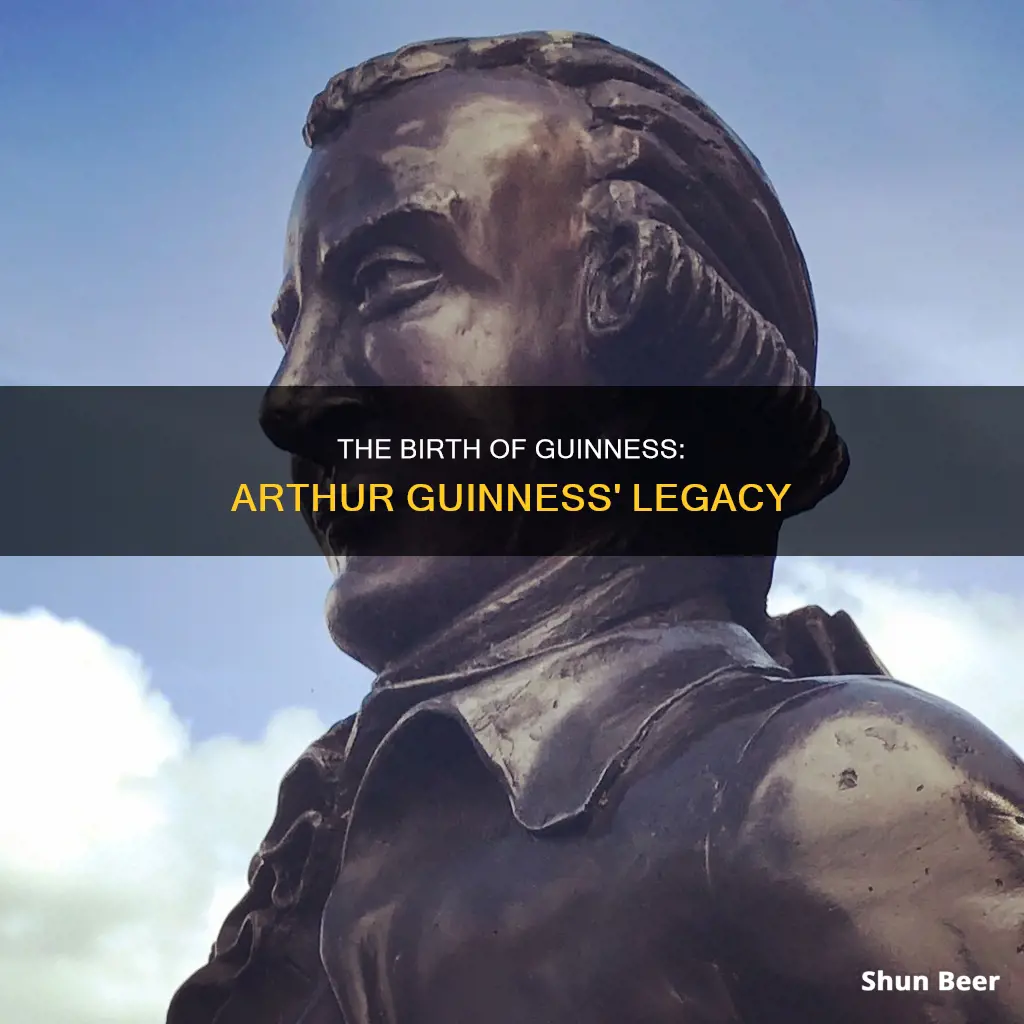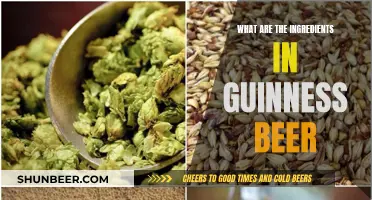
The creator of Guinness beer was Arthur Guinness, an Irish brewer, entrepreneur and philanthropist. On 31 December 1759, Guinness signed a 9,000-year lease on the St. James's Gate Brewery in Dublin, Ireland, for £45 per year. He began brewing ales in Leixlip, County Kildare, and then, from 1759, at the St. James's Gate Brewery in Dublin. In 1778, Guinness began producing porter and, by 1799, had ceased production of ale altogether.
| Characteristics | Values |
|---|---|
| Name | Arthur Guinness |
| Birthplace | Ardclogh, near Celbridge, County Kildare |
| Birthdate | c. 24 September 1725 |
| Death date | 23 January 1803 |
| Occupation | Brewer, entrepreneur, philanthropist |
| Political views | Protestant, Unionist, against Home Rule, opposed Irish independence |
| Religion | Devout Protestant |
| Family | 10 children |
| Brewery founded | St. James's Gate Brewery, Dublin, Ireland |
| Year founded | 1759 |
| Lease duration | 9,000 years |
| Annual rent | £45 |
What You'll Learn
- Arthur Guinness, the creator of Guinness beer, was a brewer, entrepreneur and philanthropist
- Guinness beer was first brewed in 1759 at St. James's Gate Brewery in Dublin, Ireland
- Guinness is now owned by Diageo, a British-based multinational alcoholic beverage maker
- Guinness is the largest brewer of stout in the world
- Guinness is available in a number of variants, including draught, extra stout and foreign extra stout

Arthur Guinness, the creator of Guinness beer, was a brewer, entrepreneur and philanthropist
Guinness was a devout Protestant and a socially and politically active individual. He founded the first Sunday school in Dublin in 1786 and frequently advocated for his fellow gentry to set a strong moral example. He supported Catholic rights in Ireland but opposed the Irish Rebellion of 1798. As a member of the Dublin Corporation of Brewers, he successfully petitioned the Irish House of Commons to change the tax code on beer imports.
In addition to his brewing business, Guinness was a philanthropist, donating to charities and working to improve healthcare access for the poor. He promoted the Gaelic arts to preserve Irish identity and advocated for tolerance in a religiously divided community.
Guinness was also an entrepreneur, displaying remarkable foresight in securing a 9,000-year lease on the St. James's Gate Brewery site. He was confident in his beer and expanded his business by adopting steam power and exporting to the English market. By the time of his death in 1803, the Guinness Brewery had become a thriving enterprise, with his son Arthur Guinness II inheriting the business and carrying on the family legacy.
Today, Guinness beer is a global brand, enjoyed by fans all over the world. The St. James's Gate Brewery in Dublin remains a popular tourist attraction, celebrating the history and craftsmanship behind this iconic beverage.
Guinness: A Manly Beer or Just Dark, Foamy Liquid?
You may want to see also

Guinness beer was first brewed in 1759 at St. James's Gate Brewery in Dublin, Ireland
Arthur Guinness was born in 1725 in County Kildare, Ireland, and grew up on the grounds of a high-ranking official in the Protestant Church, Archbishop Arthur Price. When Archbishop Price died in 1752, he bequeathed funds to the Guinness family, which allowed Arthur to purchase the abandoned St. James's Gate Brewery.
The brewery was originally an ale brewery, but Guinness began producing porter in 1778, and by 1799, production of ale ceased with the popularity of his darker beer. In 1838, St. James's Gate Brewery became the largest brewery in Ireland, and by 1886, it was the largest in the world.
Today, St. James's Gate Brewery is recognised as the world's biggest brewer of stout. The main product of the brewery is Draught Guinness, a 4.2% ABV dry stout that is one of the most successful beer brands worldwide.
Breast Milk and Guinness Beer: Any Connection?
You may want to see also

Guinness is now owned by Diageo, a British-based multinational alcoholic beverage maker
Arthur Guinness was the creator of Guinness beer. In 1759, Guinness moved to Dublin and purchased a disused brewery, where he started brewing ales. On 31 December 1759, he signed a 9,000-year lease on the unused brewery at St. James's Gate, Dublin, and began brewing ale. In 1778, Guinness started selling dark beer porter, and by 1799, production of ale ceased with the popularity of his darker beer. The first Guinness beers to use the term "stout" were Single Stout and Double Stout in the 1840s.
As a legacy of the merger, Diageo owned several non-core assets, which it gradually disposed of to focus on beverages as its core business. This included the sale of the Pillsbury Company and the Burger King fast-food restaurant chain. Diageo has grown through the acquisition of alcohol businesses around the world, including Chinese baijiu manufacturer Sichuan Shuijingfang Company, Turkish liquor company Mey Icki, Brazilian cachaça manufacturer Ypióca, and Indian United Spirits.
Diageo has also made several divestments over the years. In 2015, it sold the Red Stripe beer brand and the rights to Guinness in some territories to Heineken. It also sold most of its wine business to Treasury Wine Estates and exited the category completely with the sale of the remaining wine brands in 2019. While Diageo acquired South African beer producer United National Breweries in 2015, it divested it again in the second half of 2019.
In February 2024, Diageo announced that Debra Crew would succeed Sir Ivan Menezes as CEO of the company.
Guinness Beer: Pressurizing the Magic Balls
You may want to see also

Guinness is the largest brewer of stout in the world
Arthur Guinness was an Irish brewer, entrepreneur, and philanthropist. He purchased a 9,000-year lease on St. James's Gate Brewery, which at the time was an abandoned brewery. Over the years, Guinness expanded the brewery and began brewing porter in 1778, in addition to ale. By 1799, the production of ale ceased, and Guinness focused solely on his darker beer.
Guinness became the largest brewery in Ireland in 1838 and the largest in the world by 1886, with an annual output of 1.2 million barrels. Today, Guinness is available in over 120 countries and is one of the most successful alcohol brands worldwide.
The success of Guinness can be attributed to its unique brewing process, innovative marketing campaigns, and strong brand identity associated with Ireland. The company has also pioneered employee welfare schemes and quality control efforts, contributing to its reputation as a leading brewer.
Guinness has a rich history and a global presence, solidifying its position as the largest brewer of stout in the world.
Guinness Beer: New Recipe, Same Soulful Taste
You may want to see also

Guinness is available in a number of variants, including draught, extra stout and foreign extra stout
Arthur Guinness, an Irish brewer, entrepreneur, and philanthropist, founded the Guinness Brewery at St. James's Gate in Dublin, Ireland, in 1759. The story of Guinness began when Arthur Guinness signed a 9,000-year lease on St. James's Gate Brewery, believing in his product and its future. This entrepreneurial spirit and passion for brewing have been passed down from generation to generation, with the craft of brewing at St. James's Gate Brewery being handed down through the years.
Guinness is available in a number of variants, including draught, extra stout, and foreign extra stout, each with its unique characteristics and appeal:
Draught
Guinness Draught, the standard draught beer, is typically served from kegs, although it is also available in widget cans and bottles. It has a lower alcohol content, usually ranging from 4.1 to 4.3% ABV, and is known for its smooth, creamy texture achieved by mixing the beer with nitrogen and carbon dioxide. The draught has a rich, coffee-like flavor with a balance of sweetness and bitterness and a malty aroma. It pairs well with roasted meat, burgers, and dishes containing spinach, olives, chicory, and sprouts.
Extra Stout
Guinness Extra Stout, or simply Guinness Extra, is a bottled beer based on a porter recipe first brewed in 1821. With an ABV of around 5.5% to 5.6%, it is stronger than the draught variant. Extra Stout is not infused with nitrogen, giving it a crisper, sharper texture while still retaining the sweet and bitter blend that Guinness is known for. It has a roasted scent with hints of fruitiness and flavors of black coffee and dark cocoa. Extra Stout is a versatile beer that can be paired with a wide range of dishes, including seafood and sweet foods like ice cream and chocolate.
Foreign Extra Stout (FES)
Guinness Foreign Extra Stout, often abbreviated as FES, is the oldest variant of Guinness still available and has been brewed since 1801. It was originally known as West India Porter and was designed for export, particularly to Irish immigrants in the Caribbean. FES has a higher alcohol content, typically around 7.5% ABV, and is more heavily hopped than the draught and extra stout variants, resulting in a more bitter taste. The extra hops acted as a natural preservative for the long journeys the beer took by ship. FES constitutes almost half of Guinness's sales worldwide, especially in Africa, Asia, and the Caribbean. The flavor is unique, reminiscent of burnt toast and molasses, and it has a higher carbonation level than the Irish-brewed variant.
The Founding Story of Guinness Beer
You may want to see also







